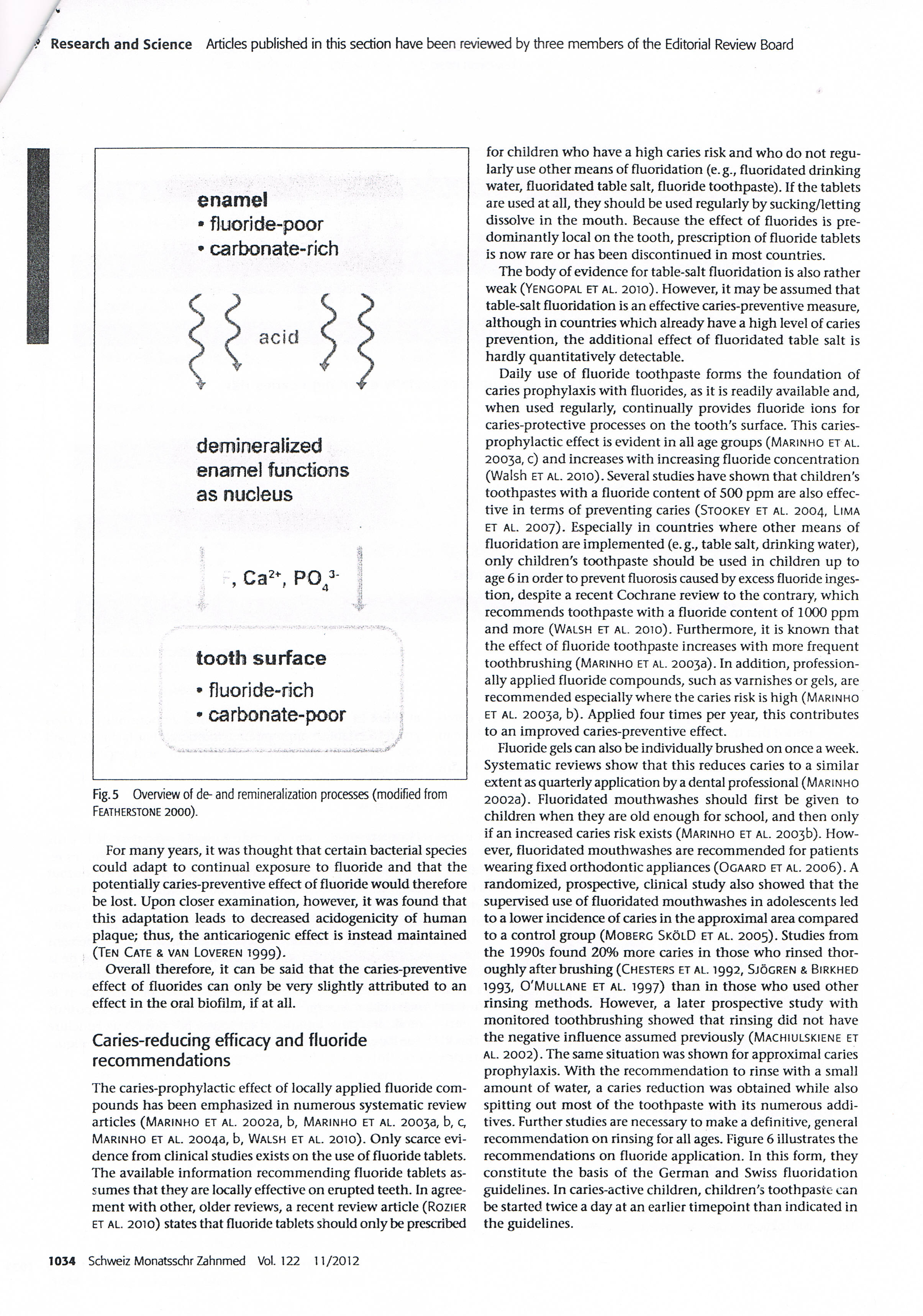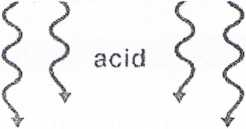CCF20130319�019

■? Research and Science Articles published in this section have been reviewed by three members of the Editorial Review Board
enamel
• fluoride-poor
• carbonate-rich

demineralized enamel functions as nucleus
t I
, Ca2+, P043' J
• 4
toołh surface
• f]uoride-rich
• carbonate-poor

Fig. 5 Overview of de- and remineralization processes (modified from Featherstone 2000).
For many years, it was thought that certain bacterial species could adapt to continual exposure to fluoride and that the potentially caries-preventive effect of fluoride would therefore be lost. Upon closer examination, however, it was found that this adaptation leads to decreased acidogenicity of human plaque; thus, the anticariogenic effect is instead maintained (Ten Cate & van Loveren 1999).
Overail therefore, it can be said that the caries-preventive effect of fluorides can only be very slightly attributed to an effect in the orał biofilm, if at all.
Caries-reducing efficacy and fluoride recommendations
The caries-prophylactic effect of locally applied fluoride com-pounds has been emphasized in numerous systematic review articles (Marinho et al. 2002a, b, Marinho et al. 20033, b, c, Marinho et al. 20043, b, Walsh et al. 2010). Only scarce evi-dence from clinical studies exists on the use of fluoride tablets. The available information recommending fluoride tablets as-sumes that they are locally effective on erupted teeth. In agree-ment with other, older reviews, a recent review article (Rozier et al. 2010) States that fluoride tablets should only be prescribed for children who have a high caries risk and who do not regu-larly use other means of fluoridation (e.g., fluoridated drinking water, fluoridated table salt, fluoride toothpaste). If the tablets are used at all, they should be used regularly by sucking/letting dissolve in the mouth. Because the effect of fluorides is pre-dominantly local on the tooth, prescription of fluoride tablets is now rare or has been discontinued in most countries.
The body of evidence for table-salt fluoridation is also rather weak (Yengopal et al. 2010). However, it may be assumed that table-salt fluoridation is an effective caries-preventive measure, although in countries which already have a high level of caries prevention, the additional effect of fluoridated table salt is hardly quantitatively detectable.
Daily use of fluoride toothpaste forms the foundation of caries prophylaxis with fluorides, as it is readily available and, when used regularly, continually provides fluoride ions for caries-protective processes on the tooth's surface. This caries-prophylactic effect is evident in all age groups (Marinho et al. 20038, c) and increases with increasing fluoride concentration (Walsh et al. 2010). Several studies have shown that children's toothpastes with a fluoride content of 500 ppm are also effec-tive in terms of preventing caries (Stookey et al. 2004, Lima et al. 2007). Especially in countries where other means of fluoridation are implemented (e. g., table salt, drinking water), only children's toothpaste should be used in children up to age 6 in order to prevent fluorosis caused by excess fluoride inges-tion, despite a recent Cochrane review to the contrary, which recommends toothpaste with a fluoride content of 1000 ppm and morę (Walsh et al. 2010). Furthermore, it is known that the effect of fluoride toothpaste increases with morę frequent toothbrushing (Marinho et al. 2003a). In addition, profession-ally applied fluoride compounds, such as vamishes or gels, are recommended especially where the caries risk is high (Marinho et al. 20033, b). Applied four times per year, this contributes to an improved caries-preventive effect.
Fluoride gels can also be individually brushed on once a week. Systematic reviews show that this reduces caries to a similar extent as quarterly application by a dental professional (Marinho 2002a). Fluoridated mouthwashes should first be given to children when they are old enough for school, and then only if an increased caries risk exists (Marinho et al. 2003b). How-ever, fluoridated mouthwashes are recommended for patients wearing fixed orthodontic appliances (Ogaard et al. 2006). A randomized, prospective, clinical study also showed that the supervised use of fluoridated mouthwashes in adolescents led to a lower inddence of caries in the approximal area compared to a control group (Moberg SkólD et al. 2005). Studies from the 1990s found 20% morę caries in those who rinsed thor-oughlyafterbrushing(CHESTERS et al. 1992, Sjogren & Birkhed 1993, 0'Mullane et al. 1997) than in those who used other rinsing methods. However, a later prospective study with monitored toothbrushing showed that rinsing did not have the negative influence assumed previously (Machiulskiene et al. 2002). The same situation was shown for approximal caries prophylaxis. With the recommendation to rinse with a smali amount of water, a caries reduction was obtained while also spitting out most of the toothpaste with its numerous addi-tives. Further studies are necessary to make a definitive, generał recommendation on rinsing for all ages. Figurę 6 illustrates the recommendations on fluoride application. In this form, they constitute the basis of the German and Swiss fluoridation guidelines. in caries-active children, children's toothpaste can be started twice a day at an earlier timepoint than indicated in the guidelines.
1034
Schweiz Monatsschr Zahnmed Vol. 122 11/2012
Wyszukiwarka
Podobne podstrony:
CCF20130319�015 Research and Science Articles published in this section have been reviewed by three
CCF20130319�017 <® Research and Science Artides published in this section have been reviewed by t
22 (899) Ir is a good idea to start by decorating a smali fiat surface, so in this section I have in
DIPLOMA Centre of Rehabilitation^ intermedicus This course has been approved by Polish Society of
CCF20130319�020 Fluorides - Modę of Action and Recommendations for Use Research and Sciencpossible a
img004 2 Tytuł oryginału Stylish Decoupage. 15 step-by-step projects to dazzle and delight First pub
Bndging By default, one bridge (brO) is defined and active. In this section you can define additiona
1 In this section we briefly discuss why it benefits your PhD program to work according to a Schedul
9 Tanzimat and “Mecelle” 115 published. In the following years further translations into variou
they are smaller and are not systematic. In this case, instead of differences, we may talk about tre
img004(2) Tytuł oryginału Stylish Decoupage. 75 step-by-step projects to dazzle and delight First pu
CCF20110521�007 Heart and blood disorders Fili in the crossword. Across 5 Irregula
00139 >858430acb91880687589de10557be5 140Simpson & KeatsEconomic-Statistical Approach Using Tra
195WELDED JOINTS Distribution of stresses in v/elaed and riveted connections, by W. Hovgaarć. Procee
więcej podobnych podstron